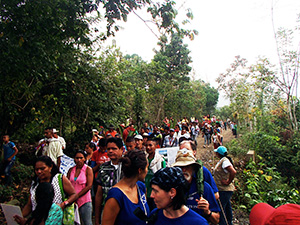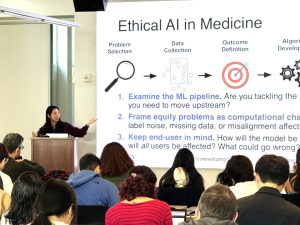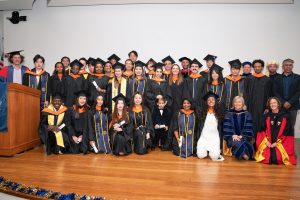By Sean Burns
There are places in the world where, if you are born into a tradition of subsistence farming and you are determined to preserve that tradition, you risk being murdered. The resource rich, Urabá region of northwestern Colombia is one such place. The reasons for this extreme danger are many and complicated, and recent UC Berkeley graduate Kaya Allan Sugerman is learning them first hand or, perhaps more precisely, hand-to-hand.
Allan Sugerman is a “human rights accompanier” for a number of marginalized villages in different parts of Colombia, the most well known of which is called La Comunidad de Paz de San José de Apartadó (Peace Community of San José de Apartadó). In 1997, campesinos from several villages declared themselves a Peace Community in an effort to advance their right for political and economic autonomy in a region plagued by violence. The communities face fierce, multi-actor warfare largely fueled through contestation over land that is ideal for drug trafficking routes. Urabá is adjacent to the border with Panama, and therefore lies at a geographical doorway to the markets of Latin and North America. The Colombian Army, state-affiliated paramilitary groups, and guerilla factions—the best known of which is the FARC—have fought for decades in this area. Civilian causality numbers are horrific. Since 1997, in the small villages of Peace Community alone, there have been 210 killings. The unprecedented 2013 report “Enough Already,” produced by Colombia’s National Center of Historical Memory, puts these numbers in an alarming national context—over 200,000 civilian casualties since 1958, most of these since the 1980s.
To compound this terror, public and private corporations seek profits through extracting the abundant, diverse natural resources of this area and other regions throughout Colombia. Water, mineral deposits, and land for corporate banana farming are at the top of the list. Corporate quests for these resources have historically resulted in mass displacement of indigenous, afro-descendent and campesino communities—an act referred to by human rights lawyers as “involuntary resettlement.” Against these multiple threats to their survival, the Peace Community, for 18 years now, has committed to a non-violent project of autonomy. From the beginning, they knew they could not walk forward alone.
This is where individuals like 25-year-old Kaya Allan Sugerman come into the picture. Allan Sugerman is a member of the international human rights organization Fellowship of Reconciliation Peace Presence (FOR Peace Presence). Its mission is to provide “physical safety, political visibility and solidarity by accompanying communities and organizations that embrace active nonviolence to defend life, land and dignity.” Very importantly, the organization’s commitment to accompany must begin with an invitation.
In 2001, shortly after two massacres in the region, the Peace Community in Colombia, which numbers around 1,500 residents, requested that FOR Peace Presence consider establishing human rights accompaniers in their villages. Human rights accompaniment is a preventative tactic increasingly used by threatened communities in many parts of the world, to diminish violence by having international volunteers physically present amidst their communities.
 The tactic works for a simple yet disconcerting reason. When poor and vulnerable communities are accompanied, or observed, by people from around the world —then the perpetrators of violence are less likely to commit atrocities for fear of retribution. Thus, human accompaniment works through the power of witnessing—a certain kind of witnessing. Its efficacy reminds us that in our world, some lives are worth more than others. Allan Sugerman, a U.S. citizen, and her fellow FOR Peace Presence members provide protection to campesinos, because they physically embody the potential of diplomatic and economic intervention by powerful, outside states. In this respect, as others have explored, the tactic is inextricably bound up with dynamics of nation, race, and class privilege.
The tactic works for a simple yet disconcerting reason. When poor and vulnerable communities are accompanied, or observed, by people from around the world —then the perpetrators of violence are less likely to commit atrocities for fear of retribution. Thus, human accompaniment works through the power of witnessing—a certain kind of witnessing. Its efficacy reminds us that in our world, some lives are worth more than others. Allan Sugerman, a U.S. citizen, and her fellow FOR Peace Presence members provide protection to campesinos, because they physically embody the potential of diplomatic and economic intervention by powerful, outside states. In this respect, as others have explored, the tactic is inextricably bound up with dynamics of nation, race, and class privilege.
Allan Sugerman’s path toward human rights accompaniment runs right through her experiences in the Blum Center’s Global Poverty & Practice minor at UC Berkeley. “I first got interested in indigenous communities struggling to maintain their land during my practice experience for the Minor,” recounts Allan Sugerman. “I traveled to Malaysia as part of a research team with Professor Gurdial Singh Nijar to assist rural communities in their defense of traditional plants and coveted, traditional medical knowledge.” When Allan Sugerman returned from the field and enrolled in her capstone GPP minor course, she was challenged to reflect on what she had learned in Malaysia and how this learning might translate into her future choices after graduation. A year after getting her diploma, Allan Sugerman was on a plane to Colombia for her first training with FOR Peace Presence.
“GPP taught me that specific injustices are rooted in larger systems of injustice,” says Allan Sugerman. “My biggest reason for signing up for the minor—and doing my work in Malaysia and Colombia—has been my concern for the historic influence of the U.S. government in fostering militarization abroad and fueling conflicts such as that in Colombia, in an effort to advance its own economic interests.”
She adds that the work of accompaniment has enabled her to carry out her commitment both to combating the immediacy of injustice—protecting people’s lives—and to understanding and changing the larger structures that produce and reproduce inequities. That is because human rights accompaniment requires two kinds of work. First, the strategic act of being physically present in the right places at the right time requires enormous amounts of research, planning, and communication. Second, for accompaniment to be successful, all of the relevant actors facing potential violence must be aware of the presence of FOR Peace Presence members. As the social landscape of struggle can often shift, this requires studying who is a threat to the community at any given time and effectively communicating with various kinds of state diplomats to ensure maximum visibility for accompanied communities. Visibility is paramount for accompaniment, and, despite it being an explicit gesture of solidarity, human rights organizations such as FOR Peace Presence must maintain an unwavering commitment to political neutrality. They are present as observers. They bring no material aid and no political opinions.
To carry out these roles, Allan Sugerman splits her time between a variety of rural villages (some coastal, some in mining-intensive areas around Cesar and Magdalena, and some in the North) and the capital city of Bogotá, population 7 million plus. This rotation enables her to conduct research and carry out vital communication in the capital, and then return to different villages three times a month with fellow accompaniers and partner organizations.
While the work of FOR Peace Presence specifically focuses on accompaniment, the broader vision for nonviolence motivates employees and volunteers to collaborate with other NGOs—some of which explicitly advance social justice advocacy work. In the fall of 2014, Allan Sugerman helped coordinate an educational speaking tour to multiple U.S. cities—including Berkeley—with partner organization Tierra Digna. The tour, entitled People, Profits and the Planet: Prospects in the Face of Corporate Supremacy, enabled Tierra Digna human rights lawyer Johana Rocha to build awareness in the U.S. around the extractive industries and large-scale development projects affecting rural Colombian areas such as Urabá. Kaya travelled with the tour as a translator and representative of FOR Peace Presence.
Having worked with FOR Peace Presence for a year and a half, Allan Sugerman has reflected intensely on the meaning and practice of accompaniment. She emphasizes that the most salient characteristic of her relationship with the people of the Peace Community is “the feeling of mutual respect—treating each other as equals.” She says, “My day-to-day interactions feel like an intercambio, a knowledge exchange.” As Allan Sugerman relays these impressions to me, I am struck by how aligned they are with a current, public conversation on the term “accompaniment” as a promising orientation for carrying out social justice work in variety of contexts.
 While FOR Peace Presence and other human rights organizations use the term to reference a specific set of protective tactics, other activists broaden its meaning to different kinds of solidarity work. In 2012, for example, U.S. labor and prisoner rights lawyer Staughton Lynd wrote an impassioned book—part memoir, part treatise—entitled Accompanying: Pathways To Social Justice. His central claim is that accompaniment, with its emphasis on humans collaborating as equals, provides an urgently needed corrective to long prevalent notions of “organizing” in North American social justice traditions. Lynd opens his book with an analysis of Dr. Paul Farmer’s well circulated 2011 commencement address at Harvard’s Kennedy School of Government—“Accompaniment as Policy”—wherein Farmer, the world-renowned founder of Partners in Health, describes his understanding of the term. Farmer’s insights stems from decades of observing development projects, some of which have failed miserably, worsening people’s lives through “unintended consequences of social action.”
While FOR Peace Presence and other human rights organizations use the term to reference a specific set of protective tactics, other activists broaden its meaning to different kinds of solidarity work. In 2012, for example, U.S. labor and prisoner rights lawyer Staughton Lynd wrote an impassioned book—part memoir, part treatise—entitled Accompanying: Pathways To Social Justice. His central claim is that accompaniment, with its emphasis on humans collaborating as equals, provides an urgently needed corrective to long prevalent notions of “organizing” in North American social justice traditions. Lynd opens his book with an analysis of Dr. Paul Farmer’s well circulated 2011 commencement address at Harvard’s Kennedy School of Government—“Accompaniment as Policy”—wherein Farmer, the world-renowned founder of Partners in Health, describes his understanding of the term. Farmer’s insights stems from decades of observing development projects, some of which have failed miserably, worsening people’s lives through “unintended consequences of social action.”
For Farmer, accompaniment is an inspiring corrective because it demands a certain kind of accountability defined both by its endurance and its humility. “I’ll go with you and support you on your journey wherever it leads,” he says of the practice. “I’ll keep you company and share your fate for a while. And by ‘a while,’ I don’t mean a little while. Accompaniment is much more often about sticking with a task until it’s deemed completed by the person or people being accompanied, rather than by the accompagnateur.” This last line foregrounds how accompaniment, as a mode of comporting oneself in social justice work, compels a specific approach to evaluating the success of our actions: those who seek to help should not serve as the measurer or the measurement tool for what is working.
As I sit in my UC Berkeley office, listening intently over Skype to Kaya Allan Sugerman share her stories from northern Colombia, thinking about their relationship to the ideas of Lynd and Farmer, I am struck by the relevance of accompaniment to the challenge of social justice.
At its most elemental level, the yearning for a more socially just world presents two problems: what and how? What is the particular vision of social justice? How to go about working toward that vision? Answers to these questions dramatically affected world events throughout the 20th century, and any current effort to advance struggles for social justice should grapple with these complex legacies and sustain these questions. Accompaniment offers a particular way into and a particular way forward for both the what and the how of social justice.
Listening, walking hand-in-hand, these are the practice.
I thank Kaya Allan Sugerman ‘12 for speaking with me; any errors in understanding or analysis are mine alone. The Global Poverty & Practice minor at UC Berkeley creates an educational community for student scholar-activists committed to exploring the difficult ethical and political questions necessary for building social justice in the 21st century.





